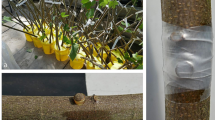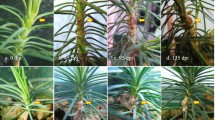Abstract
Clonostachys rosea is an important biological control agent against various plant pathogenic fungi. We collected — necrotic ponderosa and Coulter pine needles and obtained C. rosea — like fungal colonies. Cultures were identified as C. rosea and their morphological characteristics were described.
Similar content being viewed by others
References
Altschul S.F., Gish W., Miller W., Myers E.W. & Lipman D.J. 1990. Basic local alignment search tool. J. Molecul. Biol. 215: 403–410.
Alvindia D.G. & Natsuaki K.T. 2008. Evaluation of fungal epiphytes isolated from banana fruit surfaces for biocontrol of banana crown rot disease. Crop. Prot. 27: 1200–1207.
Alvindia D.G. & Hirooka Y. 2011. Identification of Clonostachys and Trichoderma spp. from banana fruit surfaces by cultural, morphological and molecular methods. Mycology 2: 109–115.
Bienapfl J.C., Floyd C.M., Percich J.A. & Malvick D.K. 2012. First report of Clonostachys rosea causing root rot of soybean in the United States. Plant Dis. 96: 1700.
Burgess D.R., Bretag T. & Keane P.J. 1997. Biocontrol of seedborne Botrytis cinerea in chickpea with Gliocladium roseum. Plant Pathol. 46: 298–305.
Cota L.V., Maffia L.A., Mizubiti E.S.G. & Macedo P.E.F. 2009. Biological control by Clonostachys rosea as a key component in the integrated management of strawberry gray mold. Biol. Control 50: 220–230.
Gams W. 1984. Generic concepts in hyphomycetes with slimy one-celled phialoconidia, pp. 465–470. In: Subramanian C.V. (ed.), Taxonomy of fungi, proceedings of the international symposium on taxonomy of fungi. Madra. 1973. University of Madras.
Gerbore J., Benhamou N., Vallance J., Le Floch G., Grizard D., Regnault R.C. & Rey P. 2014. Biological control of plant pathogens: advantages and limitations seen through the case study of Pythium oligandrum. Environ. Sci. Poll. Res. Intern. 21: 4847–4860.
Goodwin D.C. & Lee S.B. 1993. Microwave miniprep of total genomic DNA from fungi, plants, protists and animals for PCR. BioTechniques 15: 438, 441–442, 444.
Howell C.R. 1987. Relevance of mycoparasitism in the biological control of Rhizoctonia solani by Gliocladium virens. Phytopathology 77: 992–994.
Chatterton S. & Punja Z.K. 2009a. Chitinase and b-1, 3-glucanase enzyme production by the mycoparasite Clonostachys rosea f. catenulata against fungal plant pathogens. Can. J. Microb. 55: 356–367.
Chatterton S. & Punja Z.K. 2009b. Interactions between Clonostachys rosea f. catenulate, Fusarium oxysporum and cucumber roots leading to biological control of Fusarium root and stem rot. Recent developments in Management of Plant Diseases. Chapter: Plant Pathology in the 21st Century. 1: 93–106.
Ivanova H., Pristaš P. & Ondruškova E. 2016. Comparison of two Coniochaeta species (C. ligniaria and C. malacotricha) with a new pathogen of black pine needles -Sordaria macrospora. Plant Prot. Sci. 52: 18–25.
Jaklitsch W.M., Pȍldmaa K., & Samuels G.J. 2008. Reconsideration of Protocrea (Hypocreales, Hypocreaceae). Mycologia 100: 962–984.
Keinath A.P., Frawell D.R. & Papavizas G.C. 1991. Potential of Gliocladium roseum for biocontrol of Verticillium dahliae. J. Phytopathol. 81: 644–648.
Kornerup A. & Wanscher J.H. 1978. Methuen handbook of colour. London: Eyre Methuen, 252 pp.
Kornerup A. & Wanscher J.H. 1981. Taschenlexikon der Farben. Muster-Schmidt Verlag; Zürich-Göttingen.
Krauss U., Hoopen M., Rees R., Stirrup T., Argyle T., George A., Arroyo C., Corrales E. & Casanoves F. 2013. Mycoparasitism by Clonostachys byssicola and Clonostachys rosea on Trichoderma spp. from cocoa (Theobroma cacao) and implication for the desing of mixed biocontrol agents. Biol. Control 67: 317–327.
Labuda R., Krivanek L., Tancinova D., Mateova S. & Hrubcova S. 2005. Mycological survey of ripped service tree fruits (Sorbus domestica L.) with an emphasis on toxinogenic fungi. Intern. J. Food Microbiol. 99: 215–223.
Lahlali R. & Peng G. 2014. Suppression of clubroot by Clonostachys rosea via antibiosis and induced host resistance. Plant Pathology 63: 447–455.
Lukešova A. & Novakova, A. 2009. Interactions between the soil micro-flora and invertebrates in Slovak and Moravian caves, pp. 89–96. In: Tajovsky K., Schlaghamersky J & Pižl V. (eds) Contributions to Soil Zoology in Central Europe III. ISB BC AS CR, v.v.i. Ceske Budějovice.
Ogorek R., Višnovska Z. & Tančinova D. 2016. Mycobiota of Undeground Habitats. Case study of Harmanecka cave in Slovakia. Microbial Ecology 71: 87–99.
Roberti R., Badiali F., Pisi A., Pancaldi D. & Cesari A. 2006. Sensitivity of Clonostachys rosea and Trichoderma spp. as potential biocontrol agents to pesticides. J. Phytopathol. 154: 100–109.
Roberti R., Verones A.R., Cesari A., Cascone A., Di Berardina I., Bertini L. & Caruso C. 2008. Induction of PR proteins and resistance by the biocontrol agent Clonostachys rosea in wheat plants infected with Fusarium culmorum. Plant Sci. 175: 339–347.
Rodriguez M.A., Cabrera G., Gozzo F.C., Eberlin M.N. & Godeas A. 2011. Clonostachys rosea BAFC3874 as a Sclerotinia sclerotiorum antagonist: mechanisms involved and potential as a biocontrol agent. J. Appl. Microb. 110: 1177–1186.
Rogerson C.T. & Stephenson S.L. 1993. Myxomyceticolous fungi. Mycologia 85: 456–469.
Rossman A.Y., Samuels G.J., Rogerson C.T. & Lowen R. 1999. General of Bionectriaceae, Hypocreaceae and Nectriaceae (Hypocreales, Ascomycetes). Stud. Mycol. 42: 1–248.
Rossman A.Y., Seifert K.A., Samuels G.J., Minnis A.M., Schroers H.J., Lombard L., Crous P.W., P?oldmaa K., Cannon P.F., Summerbell R.C., Geiser D.M., Zhuang W.Y., Hirooka Y.
Herrera C., Salgado-Salazar C. & Chaverri P. 2013. Genera in Bionectriaceae, Hypocreaceae, and Nectriaceae (Hypocreales) proposed for acceptance or rejection. IMA Fungus. 4: 41–51.
Sambrook J., Fritsch E.F. & Maniatis T. 1989. Molecular cloning: A laboratory manual, 2nd edition. Cold Spring Harbor Lab. Press, Cold Spring Harbor, New York, 1626 pp.
Schoch C.L., Keith A., Seifert K.A., Huhndorf S., Robert V., Spouge J.L., Levesque C.A., Chen W. & Fungal Barcoding Consortium. 2012. Nuclear ribosomal internal transcribed spacer (ITS) region as a universal DNA barcode marker for Fungi. PNAS 109: 6241–6246.
Seifert K.A. 1985. A monograf of Stilbella and some alied hyphomycetes. Stud. Mycol. 27: 1–235.
Schroers H.J., Samuels G., Seifert K. & Gams W. 1999. Classification of the mycoparasite Gliocladium roseum in Clonostachys as C. rosea, its relationship to Bionectria ochroleuca, and notes on other Gliocladium-like fungi. Mycologia 91: 365–385.
Schroers H.J. 2001. A monograph of Bionectria (Ascomycota, Hypocreales, Bionectriaceae) and its Clonostachys anamorphs. Stud. Mycol. 46: 1–214.
Spatafora J.W., Sung G.H., Hywel-Jones N.L., Sung J.M. & White J.F. 2007. Phylogenetic evidence for an animal pathogen origin of ergot and the grass endophytes. Mol. Ecol. 16: 1701–1711.
Sutton J., Li D.W., Peng G., Yu H. & Zhang P. 1997. Gliocladium roseum a versatile adversary of Botrytis cinerea in crops. Plant Dis. 81: 316–328.
Sutton J.C., Liu W., Huang R. & Owen-Going N. 2002. Ability of Clonostachys rosea to establish and suppress sporulation potential of Botrytis cinerea in deleafed stems of hydroponic greenhouse tomatoes. Biocon Sci. Technol. 12: 413–425.
Ten Hoopen G.M., Rees R., Aisa P., Stirrup T. & Krauss U. 2003. Population dynamics of epiphytic mycoparasites of the genera Clonostachys and Fusarium for the biocontrol of black pod (Phytophthora palmivora) and moniliasis (Moniliophthora roreri) on cocoa (Theobroma cacao). Mycol. Res. 107: 587–596.
Theron D.J. & Holz G. 1991. Dry rot of potatoes caused by Gliocladium roseum. Plant Pathology 40: 302–305.
Toledo A.V., Scorsetti A.C., Dikgolz V.E. & López-Lastra C.C. 2004. Paecilomyces fumosoroseus y Nomuraea rileyi (Deuteromycotina: Hyphomycetes), hongos patógenos de insectos plaga de la agricultura en la Argentina. Bol. Soc. Argent. Bot. (SAB). 39: 21–26.
Toledo A.V., Virla E., Humber R.A., Paradell S.L. & López Lastra C.C. 2006. First record of Clonostachys rosea (Ascomycota: Hypocreales) as an entomophatogenic fungus of Oncometopia tucumana and Sonesimia grossa (Hemiptera: Cicadellidae) in Argentina. J. Invert. Path. 92: 7–10.
White T.J., Bruns T.D., Lee S.B. & Taylor J.W. 1990. Amplification and direct sequencing of fungal ribosomal RNA genes for phylogenetics, pp. 315–322. In: Innis M.A., Gelfand D.H., Sninsky J.J. & White T.J. (eds), PCR protocols: a guide to methods and applications. Academic Press. USA.
Xue A.G. 2003. Biological control of pathogens causing root rot complex in field pea using Clonostachys rosea strain ACM941. Phytopathology 93: 329–335.
Author information
Authors and Affiliations
Corresponding author
Rights and permissions
About this article
Cite this article
Ivanová, H., Hamarová, Ľ. & Pristaš, P. Clonostachys rosea associated with ponderosa and Coulter pine needles in Slovakia. Biologia 72, 1258–1263 (2017). https://doi.org/10.1515/biolog-2017-0145
Received:
Accepted:
Published:
Issue Date:
DOI: https://doi.org/10.1515/biolog-2017-0145




